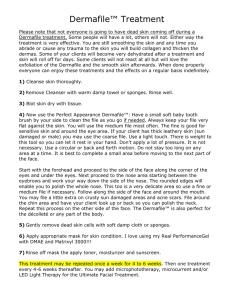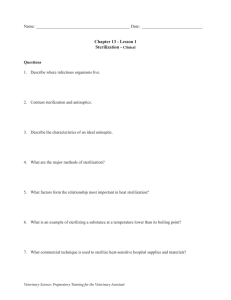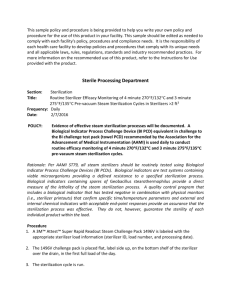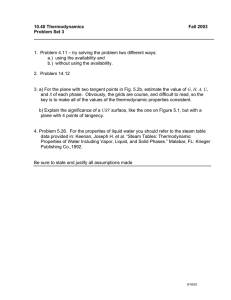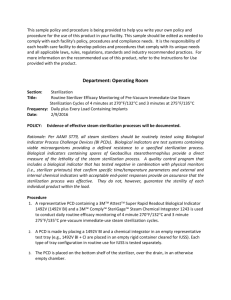STERILIZATION & PASTEURIZATION OF SOIL MIXES
advertisement
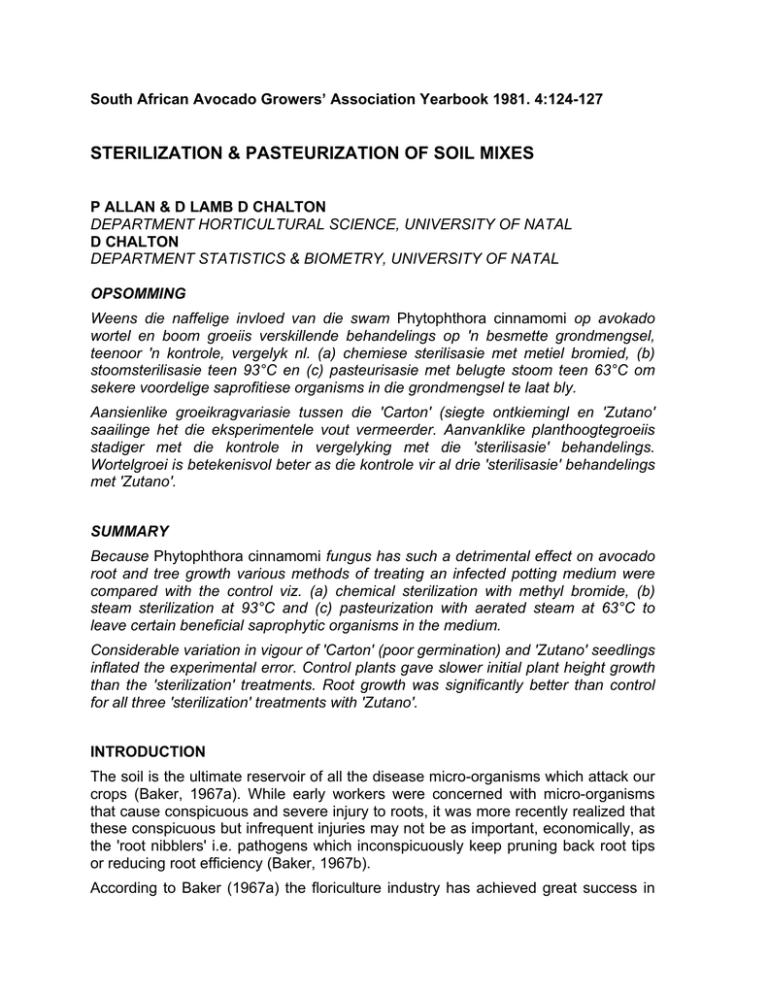
South African Avocado Growers’ Association Yearbook 1981. 4:124-127
STERILIZATION & PASTEURIZATION OF SOIL MIXES
P ALLAN & D LAMB D CHALTON
DEPARTMENT HORTICULTURAL SCIENCE, UNIVERSITY OF NATAL
D CHALTON
DEPARTMENT STATISTICS & BIOMETRY, UNIVERSITY OF NATAL
OPSOMMING
Weens die naffelige invloed van die swam Phytophthora cinnamomi op avokado
wortel en boom groeiis verskillende behandelings op 'n besmette grondmengsel,
teenoor 'n kontrole, vergelyk nl. (a) chemiese sterilisasie met metiel bromied, (b)
stoomsterilisasie teen 93°C en (c) pasteurisasie met belugte stoom teen 63°C om
sekere voordelige saprofitiese organisms in die grondmengsel te laat bly.
Aansienlike groeikragvariasie tussen die 'Carton' (siegte ontkiemingl en 'Zutano'
saailinge het die eksperimentele vout vermeerder. Aanvanklike planthoogtegroeiis
stadiger met die kontrole in vergelyking met die 'sterilisasie' behandelings.
Wortelgroei is betekenisvol beter as die kontrole vir al drie 'sterilisasie' behandelings
met 'Zutano'.
SUMMARY
Because Phytophthora cinnamomi fungus has such a detrimental effect on avocado
root and tree growth various methods of treating an infected potting medium were
compared with the control viz. (a) chemical sterilization with methyl bromide, (b)
steam sterilization at 93°C and (c) pasteurization with aerated steam at 63°C to
leave certain beneficial saprophytic organisms in the medium.
Considerable variation in vigour of 'Carton' (poor germination) and 'Zutano' seedlings
inflated the experimental error. Control plants gave slower initial plant height growth
than the 'sterilization' treatments. Root growth was significantly better than control
for all three 'sterilization' treatments with 'Zutano'.
INTRODUCTION
The soil is the ultimate reservoir of all the disease micro-organisms which attack our
crops (Baker, 1967a). While early workers were concerned with micro-organisms
that cause conspicuous and severe injury to roots, it was more recently realized that
these conspicuous but infrequent injuries may not be as important, economically, as
the 'root nibblers' i.e. pathogens which inconspicuously keep pruning back root tips
or reducing root efficiency (Baker, 1967b).
According to Baker (1967a) the floriculture industry has achieved great success in
recent decades in eliminating most of the important soil-related disease problems.
Their philosophy in preventing plant disease has been to plant clean stock in clean
soil and practice sanitation to prevent contamination.
Soils are treated with chemicals or steam to free them of disease organisms. While
chemical treatment is favoured for field use, steam is the accepted method in
floricultural operations. This is because (a) steam is the best generally effective
method of treatment; (b) penetration and effectiveness are more easily measured
(with a thermometer) than they are with chemicals; (c) soil can be treated with steam
within 30—60 cm of living plants without injuring them; (d) there is no hazard to
workmen or to neighbors from the use of steam; (e) some chemicals are ineffective
against some of the worst pathogens of floricultural crops (e.g. methyl bromide is
ineffective against Verticillium) and some chemicals leave residues toxic to some
plants (e.g. methyl bromide on carnations) (Baker, 1967a).
Steam was first used experimentally for soil sterilization in 1888 and florists and
nurserymen were only a few years behind the medical profession in adopting the
use of steam sterilization. Soil steaming became a regular procedure in greenhouse
operations and ¡n some outdoor plantings the world over. Only after 1950 were
thorough investigations of the dynamics of soil steaming conducted both from an
engineering and a biological viewpoint. This led to the development of aerated
steaming (at lower temperatures) in the late 1950's. According to Baker (1967a) this
not only saved fuel (almost half), but was biologically superior.
In 1967(a) Baker stated that it had been known for 30 years that it is only necessary
to steam soil at 60°C for 30 minutes in order to kill plant pathogenic fungi, bacteria,
nematodes, and to inactivate most viruses. The advent of aerated steaming
techniques made this practice possible. A second important biological point is that
parasitic micro-organisms are more likely to be killed at lower temperatures than are
saprophytes. This led to the hypothesis that steaming soil at 60°C would eliminate
disease organisms but leave numerous saprophytes that would be antagonistic to
the pathogens.
The ultimate problem in any soil treatment is, in fact, the subsequent
recontamination by pathogens. Overkill treatment by both full steam (100°C) and
chemicals produces essentially a biological vacuum, and the first micro-organism to
return will luxuriate. If this happens to be a pathogen severe disease loss may occur
in the crop. Treatment at minimal temperature tends to reduce the chance of a poststeaming explosive outbreak of root disease in soils where antagonistic beneficial
organisms are present.
Production of aerated steam (Baker 1967a)
Mixing air with steam dilutes it and lowers its temperature to any definite level. A
mixture of 4,1:1 by volume of air steam gives a temperature of 60°C.
By injecting a flow of steam into a larger air flow from a blower with straight radial
blades and with a damper to control the air flow, the desired mixture can easily be
obtained. An accurate thermometer is used to measure the temperature of the mix.
This mixture, which cannot rise above the 'ceiling' temperature determined by the
amount of air, is introduced at a pressure of about 15 cm water into a plenum
chamber below the soil mix. A perforated steel plate or an expanded metal screen
covered with hessian to support the mix, enables the steam: air mix to rise up
through the medium. The air, which has been heated by some of the steam, imparts
its heat to the particles and passes out of the soil. The steam condenses on any
particle cooler than itself, heating it. Thus the steam air: mix moves up through the
medium as a horizontal front, having the desired temperature on the lower side and
unheated on the upper side. There must be a ready escape for the expelled air or
the steam will not penetrate (Fig. 1).
Once the top of the medium has reached the desired temperature the damper on the
air supply can be closed and the supply of steam can be reduced to maintain the
correct temperature of the ingoing steam: air mix for 30 minutes. Experience has
shown that, to ensure a temperature of 60°C throughout the entire mix, it is better to
have the temperature of the ingoing mix slightly above 60°C e.g. 63°C (von
Broembsen, 1979). After thirty minutes pasteurization the medium should be cooled
quickly by switching off the steam, opening the damper fully and blowing air alone
through the medium. This will prevent desirable organisms from being killed.
This pasteurized medium must then be handled carefully with clean equipment to
prevent unnecessary contamination.
Effects on plant growth
Various experiments have been conducted at Pietermaritzburg over the past five
years to compare the effects of pasteurization and sterilization of soil mixes with
aerated and full steam versus untreated media on plant growth. In early work with
vegetable crops Gosling (1975) and Halse (1977) found steaming to be beneficial in
some, but not all cases. They ascribed these variations to variable levels of infection
in the media. Allan & Hobson (1979) first inoculated the media with a fungal and a
bacterial plant pathogen and fresh manure before comparing steaming at 90°C and
60°C against controls for three different vegetable crops. The yield of marketable
plant parts was generally improved by the steaming treatments. In some respects
the aerated steam was better than full steam while in others it was not. However
aerated steam was as effective as full steam in disease and pest control. Where
fresh manure had been added to the medium, growth and yield were markedly
depressed, possibly because of toxic substances, the occurrence of which was
accentuated by steaming, especially at the higher temperature.
This work was continued using nursery trees of citrus and avocado (Lamb, 1980).
The avocado experiment is described below.
PROCEDURE
The soil mix consisted of one part coarse sand, one part pine sawdust, one part
loam soil to which lime and fertilizers were added as for a U.C. mix (Hartmann &
Kester, 1975).
A culture of Phytophthora cinnamomi obtained originally from the Central Bureau for
Fungal Cultures at Baarn, Holland, was prepared on 2nd August, 1979. One part
Campbell's V-8 juice was mixed with two parts water to make up three litres of
solution to which 9 g CaC03 was added. After centrifugaron the supernatant was
mixed with an equal quantity of distilled water and 500 mf was placed in each of 20 x
1 ('flasks, before sterilization in an autoclave and aseptic inoculation with P.
cinnamomi. Good mycelial growth was obtained within four days after which the
culture was thoroughly mixed with the soil mix, together with some soil from under a
tree infected with P. cinnamomi.
Seed of two cultivars was obtained by picking fruits of Carton and Zutano at
Ukulinga research farm between 7 — 26 April and on 6 June, 1979 respectively. The
seeds were extracted from the fruits and the largest ones were cleaned, given a
fungicidal dip and stored in plastic bags at 4°C.
The “sterilization” treatments consisted of:
a).
Sterilization at 93°C.
b).
Pasteurization at 63°C.
c).
Methyl bromide fumigation using a 680 g cannister on 150 f soil mix which was
covered for two days and then aerated for 14 days.
d).
Untreated control medium.
The experiment was laid out as a randomized blocks design with four replications of
the four 'sterilization' treatments applied to both cultivars in each block. Each plot
consisted of three x 5 ℓ black plastic bags in which one seed was planted on 17th
August, 1979, after the soil mix had been leached with water in case of any toxic
residues. A few extra smaller seeds were also planted at the sides of the pots in
some replicates.
The pots were placed on raised planks in a shade house. They were watered
regularly and additional nutrients were added monthly except during
December/January. Where seeds failed to germinate the extra seedlings were
transplanted to pots of the same treatment, if available. Plant heights were
measured every two weeks until the plants were harvested on 21st April, 1980, eight
months after planting, when the masses of different plant parts were determined,
fresh and dry.
RESULTS AND DISCUSSION
Germination of the Carton seeds was poor especially in the control plots and,
despite transplanting some of the extra seedlings, there were many missing plots for
this cultivar. There was also considerable variation in vigour between the open
pollinated seedlings of the two cultivars and even within the three seedlings of a
cultivar in one 'plot' there were marked differences which inflated the experimental
error.
Plant height
The mean plant heights during the growth period for each treatment of the Zutano
and Carton plants are given in Fig. 2a and b respectively. The Zutano plants were
significantly taller than Carton because of their earlier and good germination. With
both cultivars the control plots gave the slowest initial growth but these plants had
tended to catch up to the other treatments by the time the experiment was
terminated on day 248, when there were no significant differences among
treatments for Zutano or Carton.
All three 'sterilization' treatments gave equally good ano rapid initial growth in height,
but the growth of the plants slowed down appreciably between days 150 and 200.
Inadequate nutrition and watering may have been the cause of this growth check,
because vigorous growth was resumed when extra water and nutrients were
applied.
An analysis was performed on the height of the Zutano plants at day 126
(1979.12.21) (Table 1) when the plants we-3 large enough to have been grafted.
This showed the methyl bromide treated plants to be significantly higher than the
controls although the graph shows the steam sterilization treatment to have been
slightly taller subsequently. Further analysis of this data (Fig. 3) showed that greater
precision would have been obtained with a larger number of trees in the experiment,
either by increasing the number of replications or the number of trees per plot.
However the great variability between seedlings (coefficient of variation over 30%)
was the major problem and the use of uniform clonal plants would be essential to get
reliable results.
Roots
When the plants were harvested great differences in their root systems were
observed. The considerably reduced root systems on the control plants of both
cultivars was a clear indication of the adverse effect of P. cinnamomi on avocado
root development. In contrast good root development was found on all plants in the
'sterilization' treatments. The average total fresh mass for each treatment is given in
Table 2. Zutano root systems were significantly greater than Carton. All three
'sterilization' treatments gave significantly greater fresh root mass than the control
for Zutano, and methyl bromide treatment was highly significantly better than control.
However there was no significant difference among the three 'sterilization'
treatments. With Carton all treatment differences were non significant.
It is clear that the very variable growth of the seedlings of each cultivar, irrespective
of treatment, masked the true differences between the treatments applied. This
serves to emphasize the undesirable variability that must be present in commercial
orchards grafted on seedling stocks — not only is there great variability between
rootstock cultivars but individual seedlings within a cultivar may vary tremendously in
vigour, and hence will cause variability in growth and production of orchard trees of a
given scion cultivar. The elimination of weak seedlings before grafting is essential.
The importance of clonal rootstocks to ensure uniformity of orchard trees must be
stressed, in addition to the need for clonal stocks that are tolerant of P. cinnamomi.
This experiment needs to be repeated once uniform, clonal plants can be produced,
to reduce experimental error. Despite the variability in plant growth the benefits of
one or other method of 'sterilization' of the soil mix in which avocado nursery trees
are raised, was quite apparent in the faster initial growth rate and the superior root
systems of all the 'sterilized' media compared with the infected control medium.
In a similar study on three citrus rootstock types, where more uniform nucellar
seedlings were used in infected medium, significant differences were obtained
between the 'sterilization' treatments (Lamb, 1980). For Rough lemon the
pasteurization treatment gave significantly better aerial growth than sterilization
which in turn was significantly better than control. For Empress mandarin
pasteurization and sterilization were equally superior to control. With Troyer citrange
pasteurization and sterilization gave superior total root fresh mass compared with
the control. These differences emphasize the importance of pretreatment of potting
media to eliminate harmful pathogens.
In conclusion it is clear that research must be expedited to ensure the production of
uniform avocado rootstocks that are tolerant of harmful root pathogens. However
even then the use of sanitary procedures in avocado nurseries is essential to
promote vigorous growth and a quick turn over of plants in the nursery.
ACKNOWLEDGEMENT
The authors are grateful to Miss. B.J. Bromham, Dept. Microbiology and Plant
Pathology and Mr. I.E. Smith, Dept. Horticultural Science for their assistance with
this project.
REFERENCES
ALLAN, P & JK HOBSON. 1979. Effects of steam treatment of media on growth of
three vegetable crops. Gewasproduksie/Crop Production VIII, 143 - 147.
BAKER, KF. 1967a. Control of soil-borne plant pathogens with aerated steam. Proc.
Wash. State Univ. Greenhouse Growers Inst. June 20—22, pp.3 - 18.
-----1967b. Some microbiological effects of soil treatment with steam and chemicals
Proc. Wash. State Univ. Greenhouse Growers Inst. June 20—22, pp.139 - 155.
GOSLING, I. 1975. The use of aerated steam as a means of sterilizing propagation
media. Hort. 434 project report. Univ. Natal (Unpublished).
HALSE, E. 1977. The effects of heat treatment of growing media on plant growth.
Hort. 434 project report. Univ. Natal. (Unpublished).
HARTMANN, HT & DE KESTER. 1975. Plant propagation: principles and practices.
3rd edn. Englewood Cliffs: Prentice Hall.
LAMB, D. 1980. Effects of fumigation treatment of media on growth of rootstocks of
citrus and avocado. Hort 434project report. Univ. Natal (Unpublished).
VON BROEMBSEN, SHARON. 1979. Dept. Agric. & Fisheries, Stellenbosch.
Personal communication.

